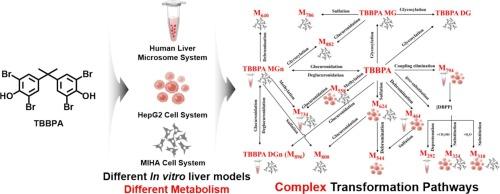多种体外肝脏模型揭示了四溴双酚A的综合生物转化途径
IF 9.7
1区 环境科学与生态学
Q1 ENVIRONMENTAL SCIENCES
引用次数: 0
摘要
四溴双酚A是一种广泛使用的溴化阻燃剂。它在人类肝脏中的生物转化引起了重大的环境和健康问题。本研究研究并比较了三种体外肝脏模型——人肝微粒体(HLM)、人肝母细胞瘤(HepG2)细胞和人正常肝细胞(MIHA)细胞系统中TBBPA的代谢。暴露结束时,TBBPA在HLM、HepG2细胞和MIHA细胞系统中的代谢率分别为92.4%、13.6%和98.4%。根据非靶标分析,共发现21种TBBPA代谢物,其中7种用于HLM, 9种用于HepG2细胞,16种用于MIHA。首次鉴定出一种新的代谢物TBBPA单β-d-葡糖苷。三种体外模型的代谢程度和代谢物类型差异显著,这可能与酶的表达和活性不同有关。通过结合这三种体外模型,证实了TBBPA的复杂转化途径,包括葡萄糖醛酸化、去葡萄糖醛酸化、硫酸化、甲基化、糖基化、脱溴化、偶联消除反应和取代,有助于更好地了解TBBPA在人体内的环境命运和健康风险评估。本文章由计算机程序翻译,如有差异,请以英文原文为准。

Diverse in vitro liver models reveal comprehensive biotransformation pathways of Tetrabromobisphenol A
Tetrabromobisphenol A is a widely used brominated flame retardant. Its biotransformation in human liver has raised significant environmental and health concerns. This study investigated and compared the metabolism of TBBPA in three in vitro liver models—human liver microsome (HLM), human hepatoblastoma (HepG2) cell, and human normal hepatocyte (MIHA) cell systems. At the end of exposure, 92.4%, 13.6%, and 98.4% of TBBPA was metabolized in HLM, HepG2 cell, and MIHA cell systems, respectively. According to the nontarget analysis, a total of 21 metabolites of TBBPA, including 7 for HLM, 9 for HepG2 cell, and 16 for MIHA, were found. A novel metabolite TBBPA mono-β-d-glucopyranoside mono-β-d-glucuronide was identified for the first time. The metabolism degrees and metabolite types differed significantly across the three in vitro models, which might be related to the different expression and activity of enzymes. By combining these three in vitro models, complex transformation pathways were confirmed, including glucuronidation, deglucuronidation, sulfation, methylation, glycosylation, debromination, coupling elimination reaction, and substitution, contributing to a better understanding of the environmental fate and health risk assessment of TBBPA in human body.
求助全文
通过发布文献求助,成功后即可免费获取论文全文。
去求助
来源期刊

Environment International
环境科学-环境科学
CiteScore
21.90
自引率
3.40%
发文量
734
审稿时长
2.8 months
期刊介绍:
Environmental Health publishes manuscripts focusing on critical aspects of environmental and occupational medicine, including studies in toxicology and epidemiology, to illuminate the human health implications of exposure to environmental hazards. The journal adopts an open-access model and practices open peer review.
It caters to scientists and practitioners across all environmental science domains, directly or indirectly impacting human health and well-being. With a commitment to enhancing the prevention of environmentally-related health risks, Environmental Health serves as a public health journal for the community and scientists engaged in matters of public health significance concerning the environment.
 求助内容:
求助内容: 应助结果提醒方式:
应助结果提醒方式:


